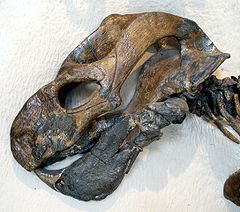Dicynodont
The Dicynodontia are a sub-group of the extinct animals called therapsids. They were small to large herbivorous (plant-eating) animals with two tusks; 'dicynodont' means 'two dog tooth'. They are also the most successful and diverse of the non-mammalian therapsids, with over 70 genera (types) known.
| Dicynodonts | |
|---|---|

| |
| Endothiodon, a Permian dicynodont | |
| Conservation status | |
Fossil
| |
| Scientific classification | |
| Kingdom: | |
| Phylum: | |
| Class: | |
| Order: | |
| Suborder: | |
| Infraorder: | Dicynodontia Owen, 1859
|

All of them had the same basic body plan. They were built like small tanks, with sturdy legs at each corner. They were not fast movers, but were obviously strong and lived in groups rather as many plant-eaters do today.[1] Their body shape was similar to certain types of modern mammals such as pigs and rhinoceros.
Fossils discovered in Poland indicate that dicynodonts survived at least until about 200 million years ago (the Upper Triassic period.[2] Six fragments of fossil skull bone discovered in Australia (Queensland) may indicate that dicynodonts survived much longer, until about 150 million years ago (the Cretaceous period) in the region called the southern Gondwana.[3]
The dicynodonts were a group of therapsids, but were not ancestors to the mammals. The group which evolved into mammals was the cynodonts.
Dicynodont Media
Diictodon life-sized model
An illustration of the skull of Dicynodon lacerticeps, first published in an 1845 description by Richard Owen
Lisowicia, a giant dicynodont from Late Triassic Poland
Eodicynodon, a primitive dicynodont from the middle Permian of South Africa
Fossil humerus of a giant Polish dicynodont, Lisowicia
Dicynodontoides, a small dicynodont from Africa's Upper Permian
References
- ↑ This is suggested by the discovery of a fossil toilet area used by Dinodontosaurus. Morgan, James 2013. Giant prehistoric toilet unearthed. BBC Science & Environment. [1]
- ↑ Dzik, Jerzy; Sulej, Tomasz & Niedźwiedzki, Grzegorz 2008. A dicynodont−theropod association in the latest Triassic of Poland (2008). "A Dicynodont-Theropod Association in the Latest Triassic of Poland". Acta Palaeontologica Polonica. 53 (4): 733–738. doi:10.4202/app.2008.0415. S2CID 54757133.
{{cite journal}}: CS1 maint: multiple names: authors list (link) [2] - ↑ Thulborn T. & Turner S. 2003. The last dicynodont: an Australian Cretaceous relict. Proceedings of the Royal Society of London B 270, 985-993. [3]